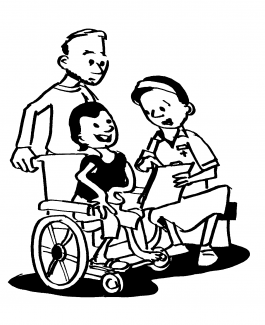Attitude
**COVID-19 specific information**
Experience has shown that a crisis of any kind tends to increase the cultural beliefs embedded in everyone. Thus, seemingly benign stereotypes that devalue people with disabilities and the elderly can be a barrier to access to health care and emergency measures. During the COVID-19 health crisis, pervasive beliefs that some people are more expendable than others led to policy delays and fostered risky behaviours towards these people.
It is therefore crucial that the emergency response deployment adopt a twin-track approach at the earliest possible stage and that communication and information be inclusive of disability.
*********************
Attitudes towards persons with disabilities are, still today, often negative and prejudicial in many countries. Persons with disabilities remains too often victims of stigma, and public perceptions of their capacities are based on stereotypes, especially towards persons with psychosocial disabilities. This results in for example discriminatory practices or over protecting attitudes. It also contribute to the neglect, mistreatment and invisibility of persons with disabilities during disasters and emergencies.
Demonstrating respectful attitudes is the best way to challenge negative attitudes. Treat people with dignity and expect all personnel to do so. For example, giving people with intellectual disabilities real choices in their daily lives can challenge assumptions and create lasting changes in the way they are treated.
Therefore adopting a respectful and positive attitude is a must for any humanitarian worker involved in emergency response and a simple disability etiquette should be followed:
- Persons with disabilities have different assistance needs and preferences of how to be supported. Most persons with disabilities live independently and do not need help, others may require assistance. Don’t assume a person wants assistance but equally be ready to offer support;
- Speak directly to a person with disability and the person that might assist her/him or the interpreter. Don’t make assumptions about someone’s level of impairment, their needs or preferences based on a previous experience of a person with the same type of impairment. Each person is individual!
- Position yourself at eye level when speaking with a person who is a wheelchair user, or of short stature;
- Identify yourself if you wish to speak to someone with sight difficulty or who is blind and remember to inform the person if you are moving away. Offer orientation of a space and describe printed information, or non-auditory communication such as videos, role play or images. Don’t leave things on the floor which could create a trip hazard;
- Feel free to ask a person who has a speech difficulty to repeat themselves, they will be used to this and will appreciate that you value their contributions and ideas;
- Approach persons with a hearing difficulties from the side or in front so as not to startle them. Ask what is their preferred communication, for example sign language or lip reading. When communicating with a deaf person maintain eye contact and speak clearly. Don’t hold anything in front of your lips, try to make sure the light is falling on your face, and don't use over exaggerated expressions. Ensure that sufficient lightning is available so that people can properly read lips and see gestures and movement. If using a sign language interpreter allow time for interpretation. Remember in some cultures being waved at or touched to gain attention can be seen as rude;
- Speak clearly and in short sentences when communicating with a person with learning disability. Do not be afraid to repeat or rephrase things to help give clarity and provide easy read materials with clear visuals. Speak normal and don't use a childish voice or exaggerate.
- Overall avoid making casual remarks that are personal or intrusive, and do not ask inappropriate questions. For example, do not say: ‘What happened to you – why can’t you walk properly?’ Remember not to touch or move any mobility aids such as a wheelchair, or white cane or guide dog unless asked to do so.
The SOLER model of non-verbal communication which is used in mental health can be an inspiring source for positioning yourself (see source below).
Finally, if you are worried about how to behave or which language to use, just ask. Persons with disabilities will prefer honesty and a genuine respect for their dignity, preferences and individuality.
